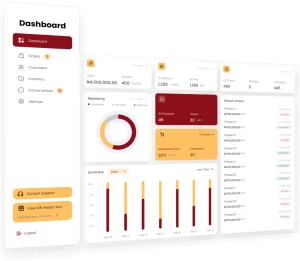Employee turnover is a critical yet often overlooked indicator of an organization’s overall health and stability. For business leaders and managers understanding the underlying causes of turnover can unlock valuable insights into company culture, employee engagement, and operational efficiency.
But what does employee turnover truly entail, and why should it be a focal point for your business strategy?
Sa artikulong ito, tatalakayin natin ang kahalagahan ng employee turnover, susuriin ang mga epekto nito, at magbibigay ng mga ekspertong estratehiya upang matulungan kang mapanatili ang pinakamahusay na talento at palakasin ang iyong organisasyon.
Table of Contents

Key Takeaways
|
What is Employee Turnover?
Employee turnover is the rate at which employees leave a company and are replaced by new hires within a specific period. It can be voluntary when employees choose to leave on their own or involuntary when departures result from decisions made by the employer.
Understanding employee turnover is crucial for business leaders as it reflects the overall work environment and can highlight potential issues in employee satisfaction and retention.
High turnover rates can lead to increased recruitment and training costs while low turnover often indicates strong employee engagement and stability within the company.
What are The Main Factors Behind High or Low Employee Turnover?
Several factors can influence employee turnover. According to research, the reasons for high or low employee turnover often vary. The following are the most common reasons for high or low employee turnover:
1. Better financial incentives and time off
One of the primary reasons employees decide to leave their current positions for new opportunities is the promise of better pay and additional time off.
Competitive salaries and generous leave policies are crucial in attracting top talent and retaining skilled employees. When companies fail to offer compensation packages that meet or exceed industry standards or when employees feel that their work-life balance is not supported, turnover rates often rise.
Employees who do not feel adequately compensated or who struggle to balance their personal and professional lives are more likely to seek out employers who offer better terms, benefits, and flexibility.
As a result, businesses that do not prioritize these aspects may face higher attrition as workers look for opportunities that better meet their financial and personal needs.
2. Improved benefits and promotion opportunities
Employees place significant value on comprehensive benefits packages which often include essential perks such as health insurance, retirement plans, and additional benefits like wellness programs or paid time off. These benefits play a crucial role in employee satisfaction and retention.
In addition to solid compensation, career advancement opportunities are also vital for keeping top talent engaged and loyal to the company. Employees who perceive limited growth potential within their current roles may feel stagnant and seek better opportunities elsewhere.
This highlights the importance of offering clear career progression paths and promotions to ensure that employees remain motivated and invested in the organization’s long-term goals.
If companies fail to address these aspects, employees experience higher turnover rates, as employees leave in search of more rewarding roles that offer better opportunities for personal and professional growth.
3. Supportive leadership and management
A supportive manager who fosters a positive work environment plays a key role in employee retention. When employees feel valued and supported, they are more likely to stay with the company.
In contrast, poor leadership can lead to dissatisfaction and higher turnover rates. Companies with ineffective management often face elevated attrition, particularly in departments with weak leadership.
Investing in strong leadership practices and a healthy work culture can help reduce turnover and improve employee satisfaction.
4. Career path development
Career path development is a crucial factor in employee retention, as it provides individuals with a clear vision of their future within the organization. When companies offer structured opportunities for career advancement and skill development, employees are more likely to stay long-term, knowing they can grow and progress in their roles.
Employees value knowing that their hard work will lead to greater responsibilities, promotions, or even cross-functional career opportunities. This sense of growth and progression fosters a deeper connection with the company, enhancing their loyalty and reducing the likelihood of them seeking opportunities elsewhere.
By focusing on career path development, organizations not only help employees achieve their professional goals but also create a more committed and motivated workforce, which can have a lasting impact on the company’s overall success.
Categories of Employee Turnover
Before diving into the specific types of employee turnover, it’s important to understand that each category has unique characteristics and implications for an organization. Narito ang isang pagsusuri ng mga pangunahing uri ng employee turnover at ang mga ibig sabihin nito:
- Voluntary turnover: This type occurs when employees choose to leave the company on their own. Common reasons include pursuing new job opportunities, personal reasons, dissatisfaction with current job conditions, or concerns related to leave balances. Managing voluntary turnover is crucial to retaining valuable talent.
- Involuntary turnover: This happens when the company decides to terminate an employee’s contract. The reasons can range from performance issues and misconduct to broader organizational needs like downsizing or restructuring. While sometimes necessary, involuntary turnover can impact morale and productivity if not handled thoughtfully.
- Retirement: Employee departures due to reaching retirement age or deciding to retire early fall under this category. Planning for retirement turnover is essential for succession planning and knowledge transfer.
- Turnover due to disability or death: These are situations where employees leave due to unforeseen personal circumstances such as severe illness, long-term disability, or death. While these cases are less controllable, companies should have compassionate policies in place to support affected employees and their families.
- Layoffs and reductions in force: These involve employees leaving due to broader workforce cuts, often tied to financial constraints or organizational changes. Effective communication and support during these periods are important to maintain trust and reduce the impact on the remaining staff.
Understanding these distinctions helps organizations implement targeted strategies to manage turnover effectively, maintain employee satisfaction, and support workforce stability.
How to Calculate Employee Turnover
Calculating employee turnover is an important step for understanding workforce stability and identifying potential retention issues. The formula for calculating the turnover rate is straightforward:
To find the turnover rate, first, count the total number of employees who left the company within a specific period such as a month or year. Next, find the average number of employees during that same period by adding the number of employees at the beginning and end of the period and dividing by two.
Finally, divide the number of departures by the average number of employees and multiply by 100 to express the turnover rate as a percentage.
How to Evaluate Your Turnover Rate
The significance of the turnover rate you have calculated depends on your industry. For instance, a 25% turnover rate may be considered normal in industries like manufacturing or retail. However, in sectors such as education, a high turnover rate should prompt further investigation into the underlying causes.
The turnover rate is more than just a statistic. It should be analyzed from various perspectives to gain a deeper understanding of the insights it reveals. To start, consider asking the following questions:
- Which employees are leaving? Are they new hires, or are they more experienced, long-term employees?
- Why are employees leaving? If it’s the new hires, is it because there’s a mismatch between their expectations and the actual job responsibilities? Perhaps additional training is needed, or your job descriptions may need to be revised to attract the right candidates. If senior employees are leaving, it might be necessary to implement an upskilling or career development program to improve retention.
- Is there a pattern in their departures? For example, if a higher number of employees are leaving just before or after the annual performance reviews, it could indicate dissatisfaction with the appraisal process or the standard salary increases.
Also read: What is Business Turnover and Why is it Important
Streamline Employee Turnover Management with HashMicro Software
Managing employee turnover efficiently is crucial for maintaining a stable and productive workforce. HashMicro’s resource management software can help streamline this process by providing tools to monitor, track, and analyze turnover trends, allowing businesses to make informed decisions. Here are some key features and benefits of using HashMicro software for turnover management:
- Centralized data management: HashMicro’s HR software consolidates employee data in one place, making it easier to track employee departures, monitor turnover rates, and access relevant information. This centralized system ensures accuracy and helps HR teams stay organized.
- Real-time analytics and reporting: The software offers real-time analytics that allows you to identify patterns in turnover, such as which departments experience higher attrition rates or if there are specific times of year when turnover peaks. These insights help HR teams take proactive measures to address the root causes of turnover.\
- Automation of HR processes: HashMicro’s resource management software automates many HRIS processes, such as generating reports, tracking employee performance, and monitoring training needs. Automation saves time and ensures HR professionals can focus on more strategic initiatives to manage turnover.
By utilizing HashMicro’s resource management software, businesses can optimize their approach to employee turnover, improve retention, and ultimately create a more stable and engaged workforce.

Conclusion
Understanding employee turnover and its impact is vital for the long-term success of your organization. High turnover can lead to increased costs, workflow disruptions, and talent loss, making it essential to address root causes.
By analyzing turnover data and trends, businesses can identify areas needing improvement, such as employee satisfaction, management practices, or recruitment strategies. This proactive approach helps reduce turnover and boost retention.
HashMicro’s resource management software simplifies managing turnover by providing tools to track and analyze data, offering insights into workforce trends for better retention strategies.
Additionally, the software automates HRIS processes, saving time and reducing the risk of human error. By leveraging HashMicro, businesses can build a more stable, engaged, and productive workforce. To explore how HashMicro can enhance your turnover management, request a free demo today.

Frequently Asked Questions About Employee Turnover
-
Why is employee turnover important?
Employee turnover is important because it can affect productivity, increase recruitment costs, and impact overall morale.
-
How can companies reduce employee turnover?
Companies can reduce turnover by offering competitive salaries, creating a positive workplace culture, and providing opportunities for career development.
-
What is the difference between voluntary and involuntary turnover?
Voluntary turnover occurs when employees leave on their own accord, while involuntary turnover happens when employees are terminated or laid off.
{
“@context”: “https://schema.org”,
“@type”: “FAQPage”,
“mainEntity”: [{
“@type”: “Question”,
“name”: “Why is employee turnover important?”,
“acceptedAnswer”: {
“@type”: “Answer”,
“text”: “Employee turnover is important because it can affect productivity, increase recruitment costs, and impact overall morale.”
}
},{
“@type”: “Question”,
“name”: “How can companies reduce employee turnover?”,
“acceptedAnswer”: {
“@type”: “Answer”,
“text”: “Companies can reduce turnover by offering competitive salaries, creating a positive workplace culture, and providing opportunities for career development.”
}
},{
“@type”: “Question”,
“name”: “What is the difference between voluntary and involuntary turnover?”,
“acceptedAnswer”: {
“@type”: “Answer”,
“text”: “Voluntary turnover occurs when employees leave on their own accord, while involuntary turnover happens when employees are terminated or laid off.”
}
}]
}













































